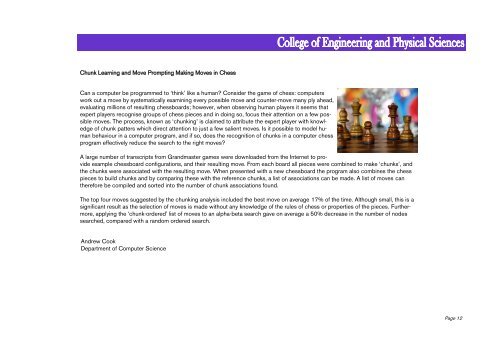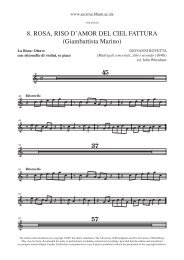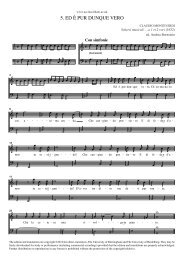Birmingham Environment for Academic Research - University of ...
Birmingham Environment for Academic Research - University of ...
Birmingham Environment for Academic Research - University of ...
- No tags were found...
You also want an ePaper? Increase the reach of your titles
YUMPU automatically turns print PDFs into web optimized ePapers that Google loves.
Chunk Learning and Move Prompting Making Moves in ChessCan a computer be programmed to ‘think’ like a human? Consider the game <strong>of</strong> chess: computerswork out a move by systematically examining every possible move and counter-move many ply ahead,evaluating millions <strong>of</strong> resulting chessboards; however, when observing human players it seems thatexpert players recognise groups <strong>of</strong> chess pieces and in doing so, focus their attention on a few possiblemoves. The process, known as ‘chunking’ is claimed to attribute the expert player with knowledge<strong>of</strong> chunk patters which direct attention to just a few salient moves. Is it possible to model humanbehaviour in a computer program, and if so, does the recognition <strong>of</strong> chunks in a computer chessprogram effectively reduce the search to the right moves?A large number <strong>of</strong> transcripts from Grandmaster games were downloaded from the Internet to provideexample chessboard configurations, and their resulting move. From each board all pieces were combined to make ‘chunks’, andthe chunks were associated with the resulting move. When presented with a new chessboard the program also combines the chesspieces to build chunks and by comparing these with the reference chunks, a list <strong>of</strong> associations can be made. A list <strong>of</strong> moves canthere<strong>for</strong>e be compiled and sorted into the number <strong>of</strong> chunk associations found.The top four moves suggested by the chunking analysis included the best move on average 17% <strong>of</strong> the time. Although small, this is asignificant result as the selection <strong>of</strong> moves is made without any knowledge <strong>of</strong> the rules <strong>of</strong> chess or properties <strong>of</strong> the pieces. Furthermore,applying the ‘chunk-ordered’ list <strong>of</strong> moves to an alpha-beta search gave on average a 50% decrease in the number <strong>of</strong> nodessearched, compared with a random ordered search.Andrew CookDepartment <strong>of</strong> Computer SciencePage 12








